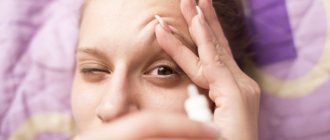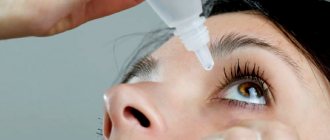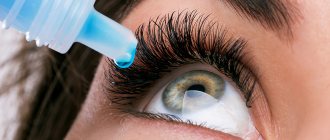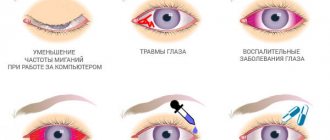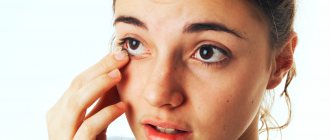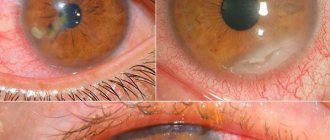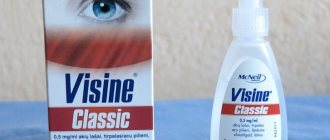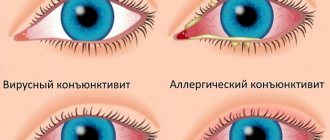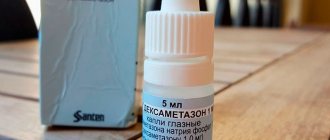Probably every person on the planet has at least once experienced the unpleasant symptoms of redness and eye fatigue. This condition is not an independent disease: modern ophthalmologists do not make such a diagnosis and do not consider eye fatigue a sign of health-threatening conditions. It’s just that the delicate tissues of the organ of vision cannot help but react to external stimuli. Stressful work behind monitors, lack of sleep and rest: the colossal stress to which we condemn our eyes leads to hyperemia and other symptoms that local medications - eye drops and ophthalmic solutions - are designed to cope with.
Eye drops for fatigue and redness: How to choose?
It is important to understand that independent selection of drops for fatigue and redness of the eyes can only be carried out in cases where a person does not have serious ophthalmological diseases of the visual system. In other cases, only a specialist can prescribe drugs. Eye drops that can eliminate the problem are:
- Vitamins - have a protective and strengthening function for the conjunctiva and cornea;
- Antibacterial - eliminate redness and pain in the eyes that occur in the presence of infectious pathologies, and can also have a protective and moisturizing effect when dry eye syndrome is detected;
- With a healing effect - reduce pain, accelerate the healing process in case of mechanical eye damage;
- Vasoconstrictors - quick-acting soothing eye drops. Please note that such drugs are intended for short-term use as they can be addictive;
- Antihistamines - relieve swelling;
- Moisturizing - used exclusively to relieve tension in the visual organs, they do not have a therapeutic effect.
You should instill remedies for eye fatigue while lying down; if you do not have this opportunity, then take a sitting position and tilt your head back. This is very important so that the drops do not flow out, but are evenly distributed throughout the conjunctiva.
Which drops to choose
The choice of medicinal solutions for treatment of red eyes is based on the collected medical history. To decide on a specific drug, the doctor:
- talks;
- examines the skin;
- checks the patient's vision;
- examines the condition of the fundus, measures intraocular pressure;
- clarifies hereditary factors, possible contraindications, talks about side effects.
Not all eye drops for redness are suitable for pregnant women and children, so buying the first remedy you come across at the pharmacy is simply unwise. The best drops for eye redness are those that suit you in all respects.
We systematize the medications based on the most common symptoms, which include red, swollen eyelids:
Classification of drops
All ophthalmic solutions, depending on the active substance, are classified into several medicinal groups.
- Antiviral and anti-inflammatory drugs are prescribed for influenza, ARVI, herpes virus, and mechanical damage to the cornea. Main signs: photophobia, swollen lymph nodes, burning sensation, swelling of the eyelids.
- Antibacterial agents are used for bacterial infections of the mucous membrane, which are manifested by purulent discharge along with pain.
- Moisturizing compositions are indicated for constant visual work, as well as while wearing contact optics.
- Antihistamine and anti-inflammatory solutions - for an allergic reaction. Swollen, reddened eyelids are accompanied by increased tearing and itching in the bridge of the nose.
- Hormonal eye solutions for irritation and itching are prescribed for severe cases of allergies.
- Vitamin compositions for red eyes increase local metabolism, accelerate regeneration, and nourish.
Vasoconstrictors
Eye drops for this type of redness cause constriction of the capillaries, relieve swelling and inflammation of the tissues of the eyelid.
Moisturizing
Increased dryness of the mucous membrane, visual fatigue, constant wearing of contact lenses - all this is a reason to daily drip ophthalmic solutions consisting of distilled water and hyaluronic acid into the eyes. Products with a similar composition create a thin film on the surface of the eyes that protects against dust and dirt.
Antiviral, anti-inflammatory
Based on scrapings from the surface of the mucous membrane or skin of the eyelids, the doctor determines the presence of a viral infection, which requires special drugs that trigger the production of interferons to combat it. Anti-inflammatory nonsteroidal and glucocorticosteroid drugs relieve swelling, eliminate itching, discomfort, and redness caused by the underlying disease. Some of the medications are sold by prescription only.
Antibacterial
Damage to the visual organs by bacteria or parasites requires treatment aimed at specific pathogens. Prescription antibacterials can be used to treat these types of infections.
Antiallergic
Antihistamines do not eliminate the cause of pain or discomfort, but they are good at relieving the symptoms of an allergic reaction by blocking the production of histamine. Solutions eliminate swelling, tearing, and redness.
Vitamin
General strengthening drugs to maintain visual health. You can take inexpensive products containing vitamins only after talking with an ophthalmologist, since most medications of this type have a cumulative effect, which can be harmful with prolonged use.
Preventive agents
To prevent the development of dry eye syndrome, as well as more severe pathologies of the visual system, it is recommended to instill moisturizing solutions during heavy workload. They will quickly relieve muscle tone, creating a protective film similar to natural tears.
Children's drops for redness and irritation of the eyes
There are no special medications for children's eyes for redness. Children are usually prescribed non-steroidal anti-inflammatory drugs and vitamin solutions. To relieve swelling, redness, and itching in children over two years of age, an instillation medicine is recommended - Sigida Crystal, produced at the Solopharm plant.
Drops overview
To gently restore the surface of the eyeball, ophthalmologists prescribe inexpensive drops with a moisturizing effect Gilan Comfort and Ultra Comfort from the St. Petersburg company Solopharm. Eye drops for redness are available in the form of convenient disposable tube droppers that are easy to take with you.
The drug with hyaluronic acid does not contain preservatives and is safe for long-term use for dry eye syndrome and intense visual work. Gilan creates a thin film on the surface of the cornea, saving the mucous membrane from drying out and inflammatory reactions. Gilan quickly eliminates stress from long-term driving, reading or working with electronic devices. The ophthalmic solution is compatible with all types of contact lenses and is approved for women during pregnancy.
Sigid crystal solution is an effective eye drop for redness caused by allergens. The vasoconstrictor ophthalmic drug contains naphazoline, is produced without preservatives, and is recommended by pediatricians for use in children aged two years and older.
Vixipin is a prescription pain reliever against inflammation and infections. The drug gently helps with corneal burns of varying degrees, hemorrhage, retinal thrombosis and other pathologies. Vixipin quickly relieves red eyes and fights the disease that caused it.
If swelling of the eyelids along with redness of the sclera occurs due to increased intraocular pressure with glaucoma, doctors prescribe the drug composition Trilactan. The drug, produced at the plant in St. Petersburg, effectively relieves feelings of fatigue and discomfort, and is recommended for the treatment of glaucoma.
How do eye drops for redness and fatigue work?
Each eye medicine contains a component that serves to perform the main therapeutic functions, as well as a number of excipients. As a rule, drops begin to act 1.5 hours after their use, their activity lasts on average from 5 to 8 hours. Ophthalmologists strongly recommend that before using eye fatigue drops, you strictly follow the rules prescribed in the manufacturer's instructions. The dosage is most often determined individually by a specialist for each patient.
Before you start using eye drops, you should wash your hands. During instillation, do not touch the tip of the bottle to the cornea of the eye. These rules must be followed to avoid infectious lesions of the visual apparatus. If, after using the drugs, the user experiences excessive lacrimation, swelling, pain, itching, redness and the inability to open the eyes, it is necessary to immediately stop treatment, such symptoms may be signs of allergic reactions.
Ophthalmologists also warn that the use of drops for fatigue and redness of the eyes is contraindicated in pathologies such as stye and conjunctivitis, if these drugs are not intended for this. Many modern products effectively combat dry eye syndrome and help get rid of increased tear production and improve the penetration of oxygen to the cornea. This relieves the user of redness in the visual organs and has a preventive effect on the occurrence of viral pathologies, since some of the harmful microflora die precisely upon contact with oxygen.
Signs of eye fatigue
The fact that the eyes are tired and need rest can be concluded from the following symptoms:
- scleral hyperemia (redness of the whites of the eyes in an adult or child);
- a bright vascular network appears;
- vision problems: decreased sharpness, appearance of fog, blurred vision, diplopia;
- feeling of dryness in the eyes;
- increased lacrimation;
- sensation of sand, foreign body;
- pain when moving the eyeballs;
- headache;
- disturbances in visual focusing (impossibility to focus for a long time on close objects), etc.
The most effective drugs
Drops for visual fatigue are presented on the ophthalmological market in huge quantities. They can be based on various components; there are also analogues. The most popular and effective drugs include:
- “Systane” is a product made from components that are similar in composition and properties to natural human tears. After instillation, the drug forms a film that moisturizes the cornea, preventing dryness, redness and rapid eye fatigue, protecting them from negative environmental factors. Use drops no more than 1-2 times a day.
- “Vizin” has an anesthetic and vasoconstrictor effect, instantly relieving visual fatigue. It is recommended to use 3 times a day.
- "Kornergel" - indicated for discomfort when working with a computer for a long time or as a result of using contact vision correction. The product can be taken 3 to 5 times a day, depending on need.
- “Visomitin” is a drug created on the basis of active substances that help moisturize eye tissue and stimulate metabolic processes. The drops also have not only a protective, but also a restorative effect. Can be used 3 times a day.
- “Inoxa” - drops have a moisturizing function and relieve fatigue. Perfect for people whose work involves long periods of work at the computer. The drug can be instilled if necessary, but not more than 4 times a day.
Causes of red eyes
Reasons that lead to discomfort include:
- Prolonged exposure to electromagnetic radiation. TV, computer or smartphone screen: our eyes are almost constantly directed at the source of electromagnetic rays. The conjunctiva quickly reacts to them with redness and a burning sensation.
- Lack of sleep. Redness of the eyes is a consequence of a violation of the daily routine.
- Ambient conditions. Strong wind, air dried out by air conditioners or radiators, bright sunlight, dust, flowering. There are many factors that can lead to red eyes.
- Pathological conditions. Among them are inflammatory diseases, dry eye syndrome, and muscle weakness. Of course, in these cases, redness and a feeling of fatigue in the eyes will only be symptoms of a disease that must be treated. However, even in these conditions, eye drops can make you feel better. The main thing is that they do not become a substitute for treatment.
- Non-compliance with the wearing regime or incorrect selection of contact lenses. Redness of the eyes from lenses occurs if you do not clean the lenses well or forget to remove them on time.
Inexpensive drops for tired and red eyes
Many people, when choosing remedies for fatigue and redness of the visual organs, are wondering: to give preference to an expensive drug or to limit themselves to inexpensive analogue drugs. There is no definite answer to this question, since there are drops that in their action are practically no different from expensive drugs. The final decision must be made by a specialist, since it is not the price of the product that is important, but its composition.
If the redness of the eyes is associated precisely with their fatigue, and not with dystrophic lesions or the presence of infection, then you can purchase an inexpensive medicine that will definitely be effective. Among these drugs:
- “Oftagel” - drops instantly form a protective film without connecting with the tear film and preventing its evaporation from the surface of the conjunctiva. Drops can be used no more than 4 times a day.
- “Oxial” - the drug is made on the basis of hyaluronic acid, is biocompatible and interacts well with the tissues of the cornea, forming a protective layer that does not evaporate. The medicine can be used up to 6 times a day depending on need.
- "Octilia" - the solution relieves redness and swelling. Before use, you should consult a specialist, since the product has a number of side effects. You can instill up to 3 times a day.
- “Natural tear” can be used to moisturize the visual apparatus, but the product does not always work effectively in reducing eye fatigue. It should be instilled for no more than 3-4 days, since later the drops cease to have an effect.
- "Vita-iodurol" - vitamin drops that help strengthen eye tissue. The drug is not a symptomatic medicine; in practice it is used for prevention. Instilled up to 3 times a day, the duration is arbitrary.
Preventive agents
Many eye drops are prescribed not only for treatment, but also for the prevention of infectious lesions, the development of irritation when wearing contact correction devices, and increasing IOP. Sulfacyl sodium, Normax, Okomistin are used to prevent infection. In order to prevent the development of diseases associated with constant eye fatigue, increased visual stress, and negative external influences, Visin and Octilia can be used.
First aid if something gets in your eyes
If a foreign object gets into the eye, provide first aid. If there is minor damage, this can be done at home. But if blepharospasm or extensive damage occurs, contact an ophthalmologist or traumatologist.
First aid is carried out in several stages:
- Anesthesia. It is used if the patient is unable to open his eyes. Use solutions of lidocaine and novocaine. They are dripped in limited quantities, as they cause side effects with prolonged action.
- The person is placed in a dark room to reduce the strain on the visual organs. This eliminates photophobia and the patient can open the eyelids.
- Washing. It is better to use an antiseptic solution. Furacilin is suitable for this. Dissolve 1 tablet in a glass of water. Pharmacies sell ready-made solutions. The drug is instilled directly into the eyes. If this does not help, liquid is poured into the cup, and the victim lowers his open eyes into it. The fluid inside is blinked to remove the foreign body from the mucous membrane.
- If a foreign body causes a burn, you cannot do without the help of a doctor. He will remove the foreign object using ophthalmic instruments.
- Antibiotic instillation. This step is required to exclude a bacterial infection. The medicine is used for up to 7 days. They use Vigamox, Tobrex.
After completing first aid, the person is discharged home. There he must continue therapy. Ointments are used that improve the regeneration of damaged tissue, for example, Solcoseryl or Korneregel.
Anti-inflammatory drugs are used to relieve redness and swelling. For example, Visin. You can use it for no more than 4 days, after which it becomes addictive.
1 week after completing home treatment, return to see an ophthalmologist. He checks the functional condition of the eyes and assesses the degree of wound healing. If complications arise, he adjusts treatment methods.
When providing first aid, it is prohibited to try to remove a foreign object using your fingers. Cold and hot water should not be used for rinsing, as the cornea is irritated; warm solutions are used.
